Personal Reflection: Teamwork & Technology in Organizations
VerifiedAdded on 2023/06/13
|18
|4196
|91
Essay
AI Summary
This essay provides a personal reflection on teamwork and technology in organizations, drawing from internship experiences at Samsung and ABC Limited. The author analyzes the dynamics of teamwork using Tuckman's Stages of Group Development, highlighting challenges faced due to lack of coordination and communication. The impact of technology on work productivity is also examined, noting resistance to new technologies. The essay concludes with recommendations for improving teamwork through team-building sessions, regular meetings, incentives, and celebrating successes, as well as addressing technology adoption challenges to enhance organizational effectiveness. This document is available on Desklib, a platform offering study tools and resources for students.
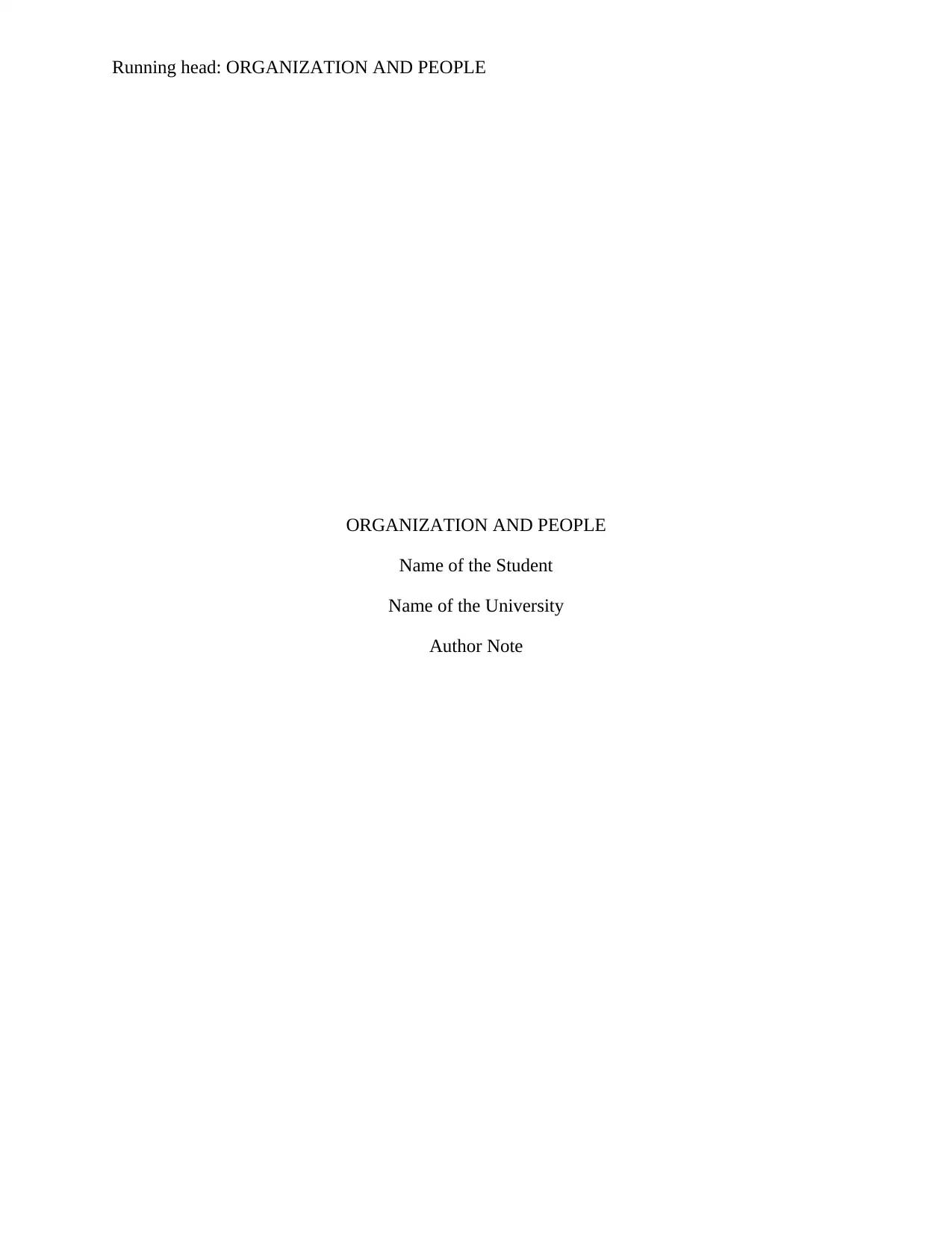
Running head: ORGANIZATION AND PEOPLE
ORGANIZATION AND PEOPLE
Name of the Student
Name of the University
Author Note
ORGANIZATION AND PEOPLE
Name of the Student
Name of the University
Author Note
Paraphrase This Document
Need a fresh take? Get an instant paraphrase of this document with our AI Paraphraser
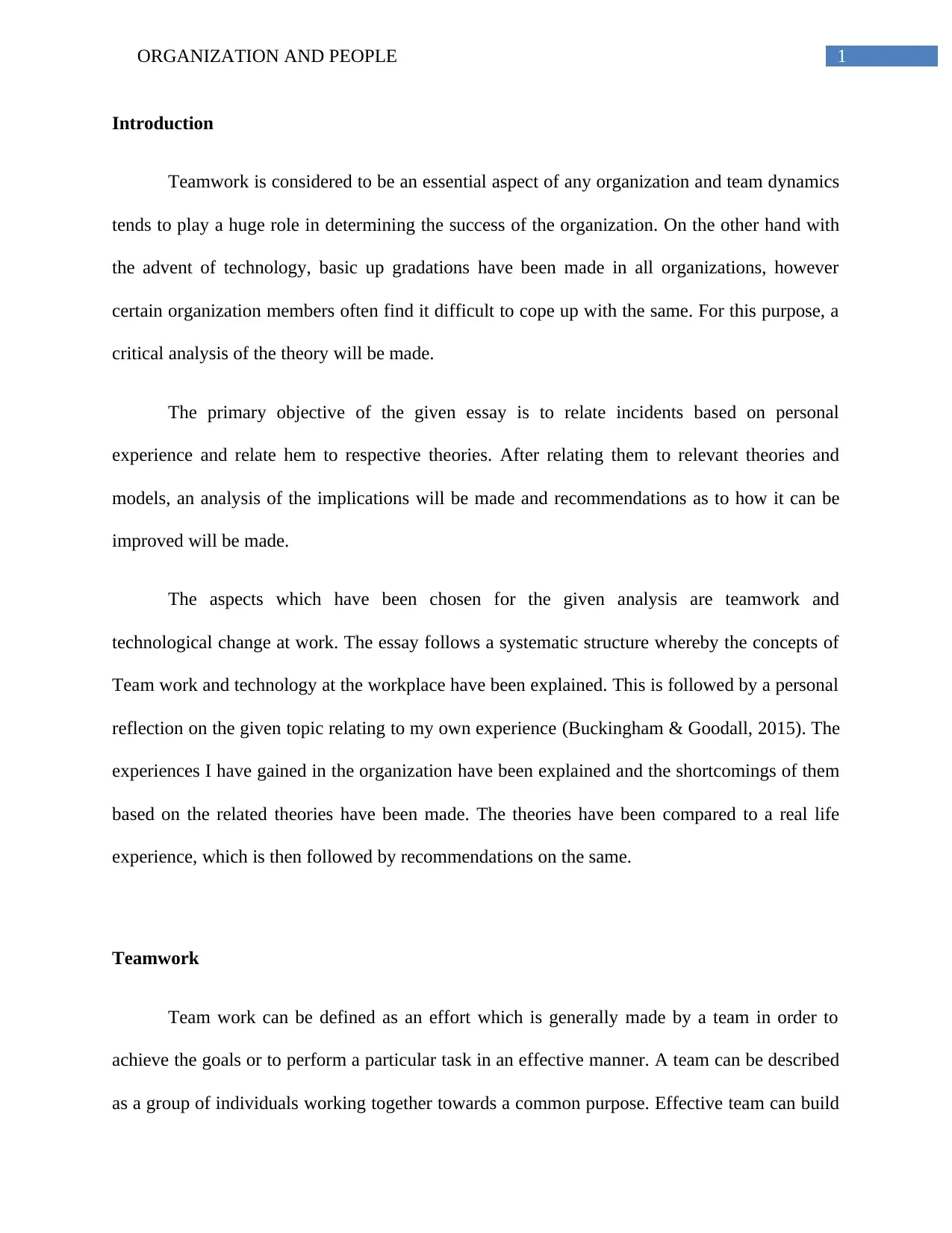
1ORGANIZATION AND PEOPLE
Introduction
Teamwork is considered to be an essential aspect of any organization and team dynamics
tends to play a huge role in determining the success of the organization. On the other hand with
the advent of technology, basic up gradations have been made in all organizations, however
certain organization members often find it difficult to cope up with the same. For this purpose, a
critical analysis of the theory will be made.
The primary objective of the given essay is to relate incidents based on personal
experience and relate hem to respective theories. After relating them to relevant theories and
models, an analysis of the implications will be made and recommendations as to how it can be
improved will be made.
The aspects which have been chosen for the given analysis are teamwork and
technological change at work. The essay follows a systematic structure whereby the concepts of
Team work and technology at the workplace have been explained. This is followed by a personal
reflection on the given topic relating to my own experience (Buckingham & Goodall, 2015). The
experiences I have gained in the organization have been explained and the shortcomings of them
based on the related theories have been made. The theories have been compared to a real life
experience, which is then followed by recommendations on the same.
Teamwork
Team work can be defined as an effort which is generally made by a team in order to
achieve the goals or to perform a particular task in an effective manner. A team can be described
as a group of individuals working together towards a common purpose. Effective team can build
Introduction
Teamwork is considered to be an essential aspect of any organization and team dynamics
tends to play a huge role in determining the success of the organization. On the other hand with
the advent of technology, basic up gradations have been made in all organizations, however
certain organization members often find it difficult to cope up with the same. For this purpose, a
critical analysis of the theory will be made.
The primary objective of the given essay is to relate incidents based on personal
experience and relate hem to respective theories. After relating them to relevant theories and
models, an analysis of the implications will be made and recommendations as to how it can be
improved will be made.
The aspects which have been chosen for the given analysis are teamwork and
technological change at work. The essay follows a systematic structure whereby the concepts of
Team work and technology at the workplace have been explained. This is followed by a personal
reflection on the given topic relating to my own experience (Buckingham & Goodall, 2015). The
experiences I have gained in the organization have been explained and the shortcomings of them
based on the related theories have been made. The theories have been compared to a real life
experience, which is then followed by recommendations on the same.
Teamwork
Team work can be defined as an effort which is generally made by a team in order to
achieve the goals or to perform a particular task in an effective manner. A team can be described
as a group of individuals working together towards a common purpose. Effective team can build
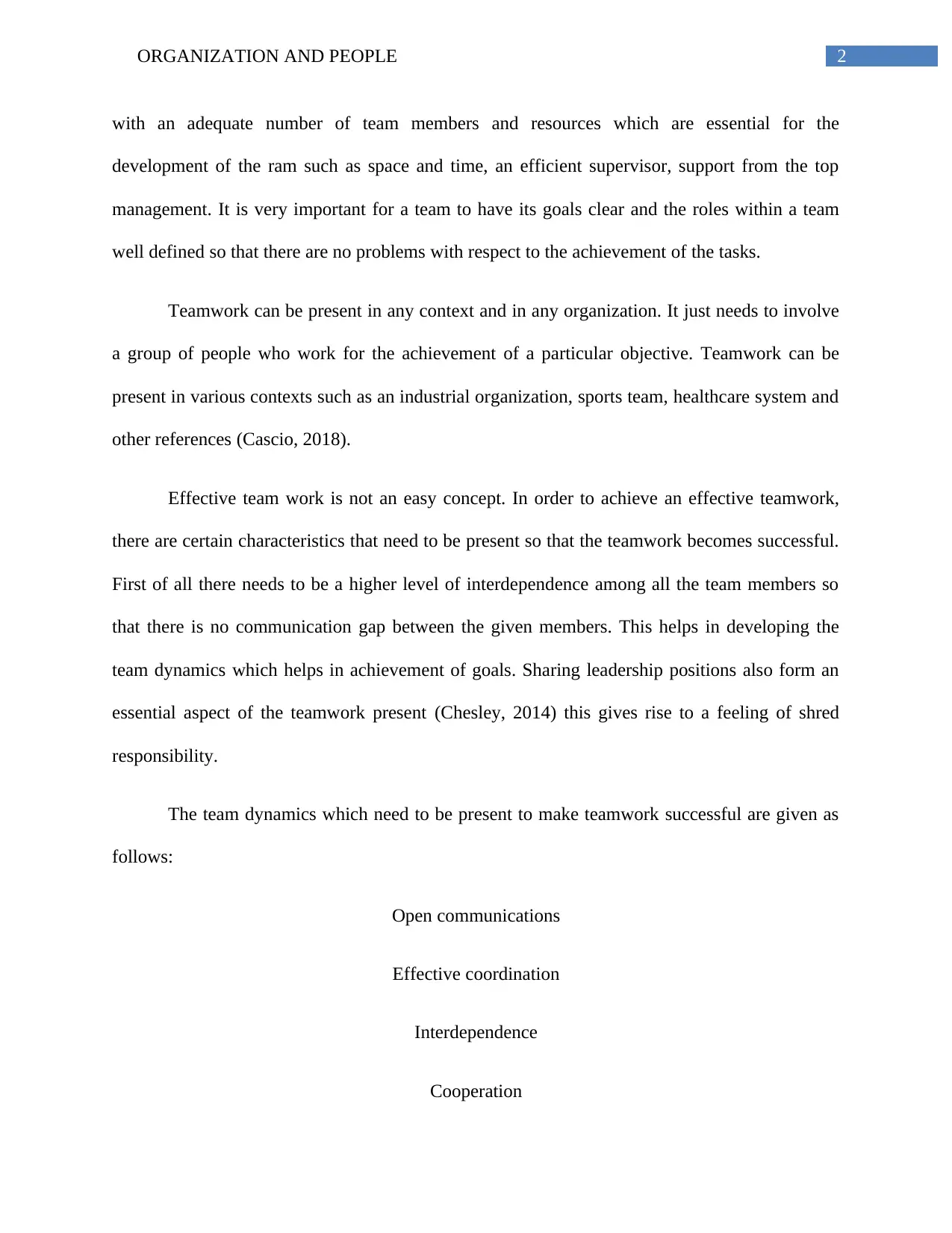
2ORGANIZATION AND PEOPLE
with an adequate number of team members and resources which are essential for the
development of the ram such as space and time, an efficient supervisor, support from the top
management. It is very important for a team to have its goals clear and the roles within a team
well defined so that there are no problems with respect to the achievement of the tasks.
Teamwork can be present in any context and in any organization. It just needs to involve
a group of people who work for the achievement of a particular objective. Teamwork can be
present in various contexts such as an industrial organization, sports team, healthcare system and
other references (Cascio, 2018).
Effective team work is not an easy concept. In order to achieve an effective teamwork,
there are certain characteristics that need to be present so that the teamwork becomes successful.
First of all there needs to be a higher level of interdependence among all the team members so
that there is no communication gap between the given members. This helps in developing the
team dynamics which helps in achievement of goals. Sharing leadership positions also form an
essential aspect of the teamwork present (Chesley, 2014) this gives rise to a feeling of shred
responsibility.
The team dynamics which need to be present to make teamwork successful are given as
follows:
Open communications
Effective coordination
Interdependence
Cooperation
with an adequate number of team members and resources which are essential for the
development of the ram such as space and time, an efficient supervisor, support from the top
management. It is very important for a team to have its goals clear and the roles within a team
well defined so that there are no problems with respect to the achievement of the tasks.
Teamwork can be present in any context and in any organization. It just needs to involve
a group of people who work for the achievement of a particular objective. Teamwork can be
present in various contexts such as an industrial organization, sports team, healthcare system and
other references (Cascio, 2018).
Effective team work is not an easy concept. In order to achieve an effective teamwork,
there are certain characteristics that need to be present so that the teamwork becomes successful.
First of all there needs to be a higher level of interdependence among all the team members so
that there is no communication gap between the given members. This helps in developing the
team dynamics which helps in achievement of goals. Sharing leadership positions also form an
essential aspect of the teamwork present (Chesley, 2014) this gives rise to a feeling of shred
responsibility.
The team dynamics which need to be present to make teamwork successful are given as
follows:
Open communications
Effective coordination
Interdependence
Cooperation
⊘ This is a preview!⊘
Do you want full access?
Subscribe today to unlock all pages.

Trusted by 1+ million students worldwide
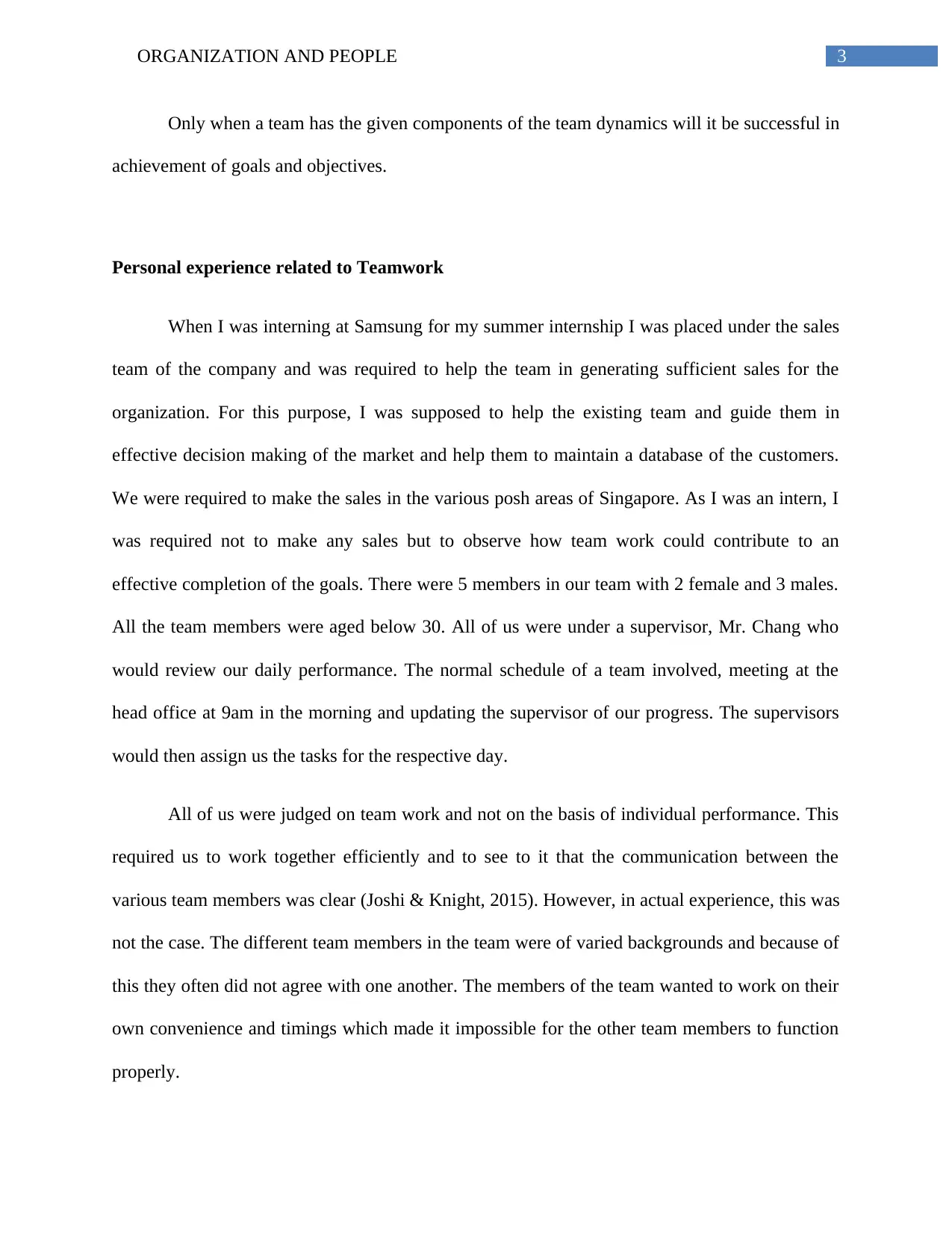
3ORGANIZATION AND PEOPLE
Only when a team has the given components of the team dynamics will it be successful in
achievement of goals and objectives.
Personal experience related to Teamwork
When I was interning at Samsung for my summer internship I was placed under the sales
team of the company and was required to help the team in generating sufficient sales for the
organization. For this purpose, I was supposed to help the existing team and guide them in
effective decision making of the market and help them to maintain a database of the customers.
We were required to make the sales in the various posh areas of Singapore. As I was an intern, I
was required not to make any sales but to observe how team work could contribute to an
effective completion of the goals. There were 5 members in our team with 2 female and 3 males.
All the team members were aged below 30. All of us were under a supervisor, Mr. Chang who
would review our daily performance. The normal schedule of a team involved, meeting at the
head office at 9am in the morning and updating the supervisor of our progress. The supervisors
would then assign us the tasks for the respective day.
All of us were judged on team work and not on the basis of individual performance. This
required us to work together efficiently and to see to it that the communication between the
various team members was clear (Joshi & Knight, 2015). However, in actual experience, this was
not the case. The different team members in the team were of varied backgrounds and because of
this they often did not agree with one another. The members of the team wanted to work on their
own convenience and timings which made it impossible for the other team members to function
properly.
Only when a team has the given components of the team dynamics will it be successful in
achievement of goals and objectives.
Personal experience related to Teamwork
When I was interning at Samsung for my summer internship I was placed under the sales
team of the company and was required to help the team in generating sufficient sales for the
organization. For this purpose, I was supposed to help the existing team and guide them in
effective decision making of the market and help them to maintain a database of the customers.
We were required to make the sales in the various posh areas of Singapore. As I was an intern, I
was required not to make any sales but to observe how team work could contribute to an
effective completion of the goals. There were 5 members in our team with 2 female and 3 males.
All the team members were aged below 30. All of us were under a supervisor, Mr. Chang who
would review our daily performance. The normal schedule of a team involved, meeting at the
head office at 9am in the morning and updating the supervisor of our progress. The supervisors
would then assign us the tasks for the respective day.
All of us were judged on team work and not on the basis of individual performance. This
required us to work together efficiently and to see to it that the communication between the
various team members was clear (Joshi & Knight, 2015). However, in actual experience, this was
not the case. The different team members in the team were of varied backgrounds and because of
this they often did not agree with one another. The members of the team wanted to work on their
own convenience and timings which made it impossible for the other team members to function
properly.
Paraphrase This Document
Need a fresh take? Get an instant paraphrase of this document with our AI Paraphraser
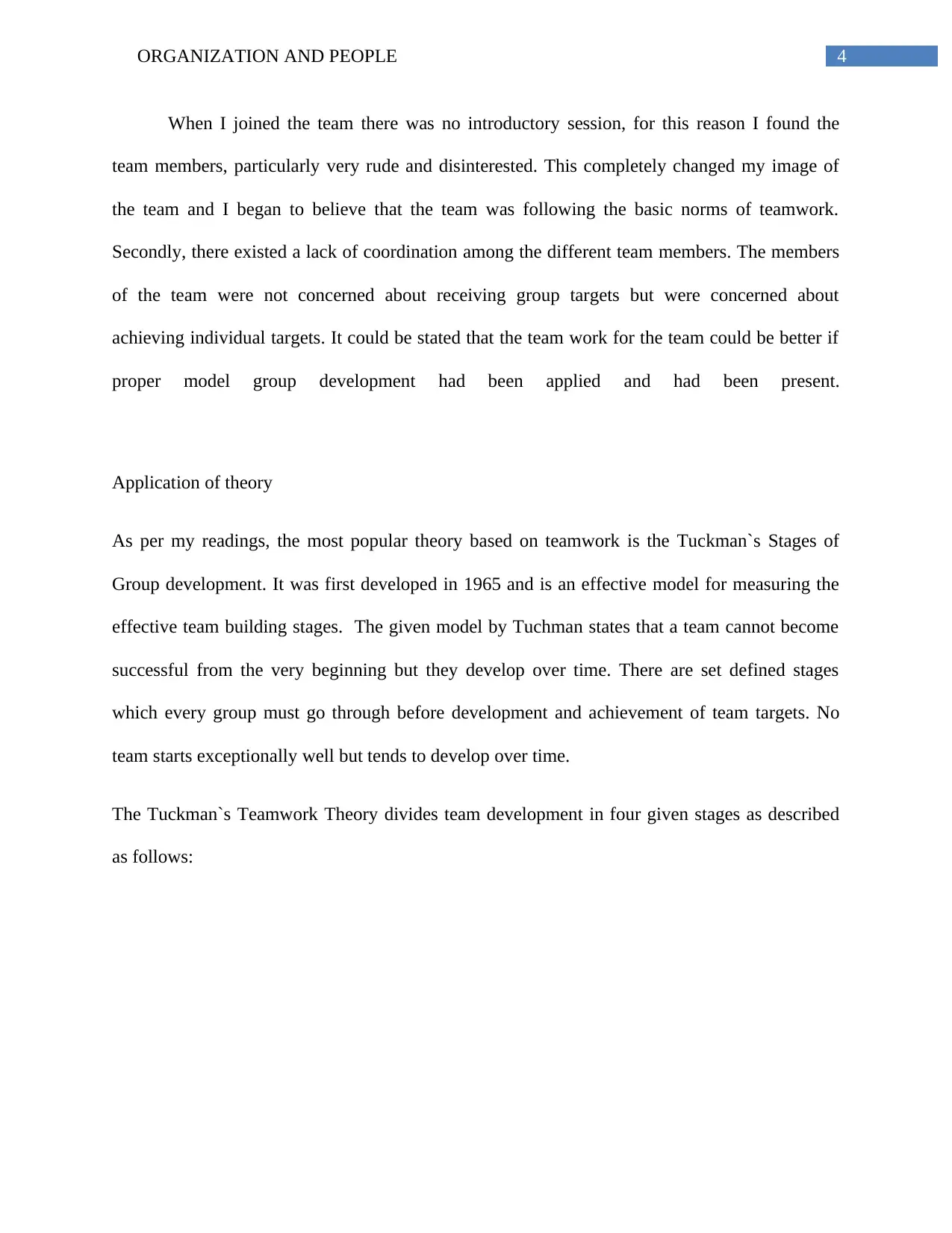
4ORGANIZATION AND PEOPLE
When I joined the team there was no introductory session, for this reason I found the
team members, particularly very rude and disinterested. This completely changed my image of
the team and I began to believe that the team was following the basic norms of teamwork.
Secondly, there existed a lack of coordination among the different team members. The members
of the team were not concerned about receiving group targets but were concerned about
achieving individual targets. It could be stated that the team work for the team could be better if
proper model group development had been applied and had been present.
Application of theory
As per my readings, the most popular theory based on teamwork is the Tuckman`s Stages of
Group development. It was first developed in 1965 and is an effective model for measuring the
effective team building stages. The given model by Tuchman states that a team cannot become
successful from the very beginning but they develop over time. There are set defined stages
which every group must go through before development and achievement of team targets. No
team starts exceptionally well but tends to develop over time.
The Tuckman`s Teamwork Theory divides team development in four given stages as described
as follows:
When I joined the team there was no introductory session, for this reason I found the
team members, particularly very rude and disinterested. This completely changed my image of
the team and I began to believe that the team was following the basic norms of teamwork.
Secondly, there existed a lack of coordination among the different team members. The members
of the team were not concerned about receiving group targets but were concerned about
achieving individual targets. It could be stated that the team work for the team could be better if
proper model group development had been applied and had been present.
Application of theory
As per my readings, the most popular theory based on teamwork is the Tuckman`s Stages of
Group development. It was first developed in 1965 and is an effective model for measuring the
effective team building stages. The given model by Tuchman states that a team cannot become
successful from the very beginning but they develop over time. There are set defined stages
which every group must go through before development and achievement of team targets. No
team starts exceptionally well but tends to develop over time.
The Tuckman`s Teamwork Theory divides team development in four given stages as described
as follows:
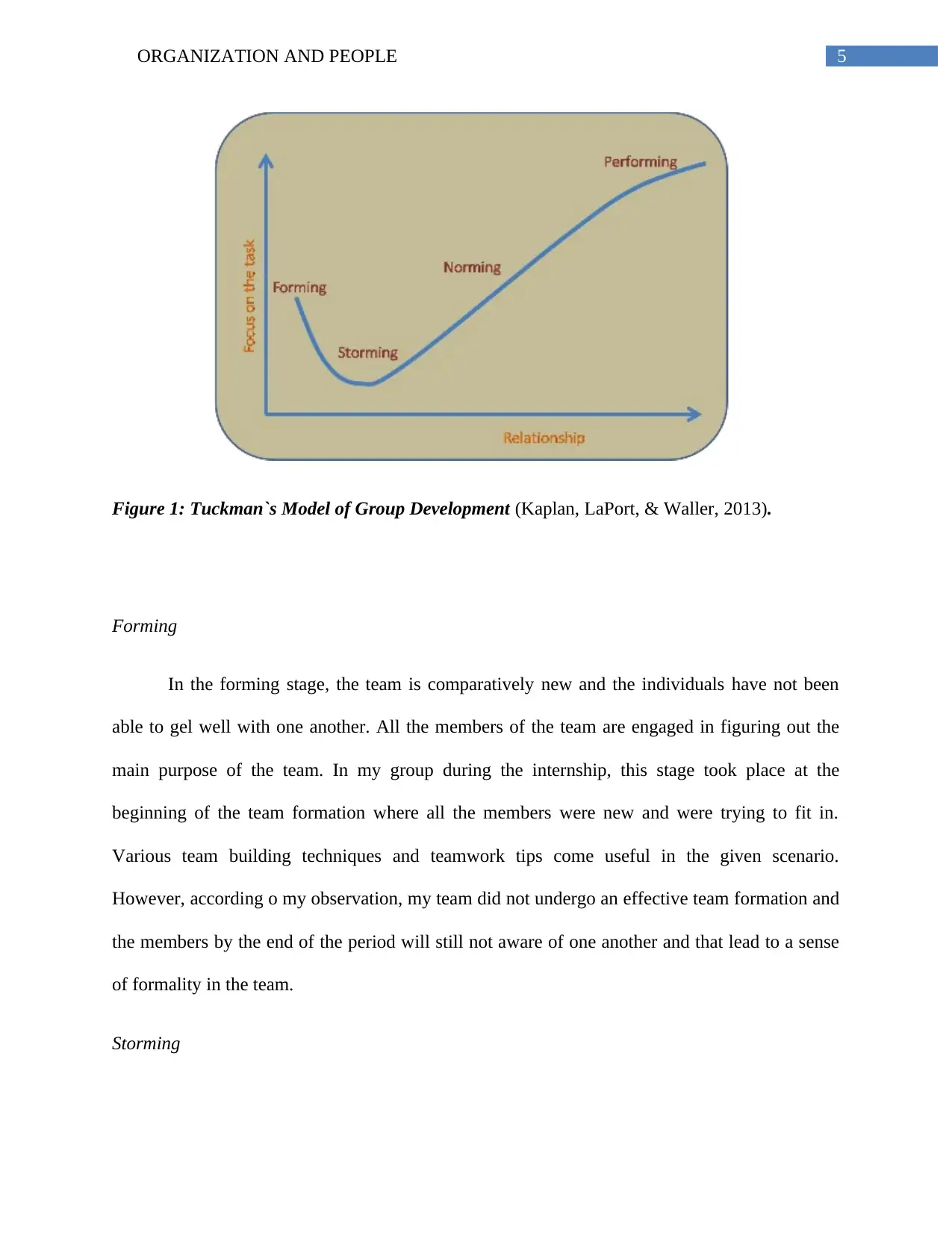
5ORGANIZATION AND PEOPLE
Figure 1: Tuckman`s Model of Group Development (Kaplan, LaPort, & Waller, 2013).
Forming
In the forming stage, the team is comparatively new and the individuals have not been
able to gel well with one another. All the members of the team are engaged in figuring out the
main purpose of the team. In my group during the internship, this stage took place at the
beginning of the team formation where all the members were new and were trying to fit in.
Various team building techniques and teamwork tips come useful in the given scenario.
However, according o my observation, my team did not undergo an effective team formation and
the members by the end of the period will still not aware of one another and that lead to a sense
of formality in the team.
Storming
Figure 1: Tuckman`s Model of Group Development (Kaplan, LaPort, & Waller, 2013).
Forming
In the forming stage, the team is comparatively new and the individuals have not been
able to gel well with one another. All the members of the team are engaged in figuring out the
main purpose of the team. In my group during the internship, this stage took place at the
beginning of the team formation where all the members were new and were trying to fit in.
Various team building techniques and teamwork tips come useful in the given scenario.
However, according o my observation, my team did not undergo an effective team formation and
the members by the end of the period will still not aware of one another and that lead to a sense
of formality in the team.
Storming
⊘ This is a preview!⊘
Do you want full access?
Subscribe today to unlock all pages.

Trusted by 1+ million students worldwide
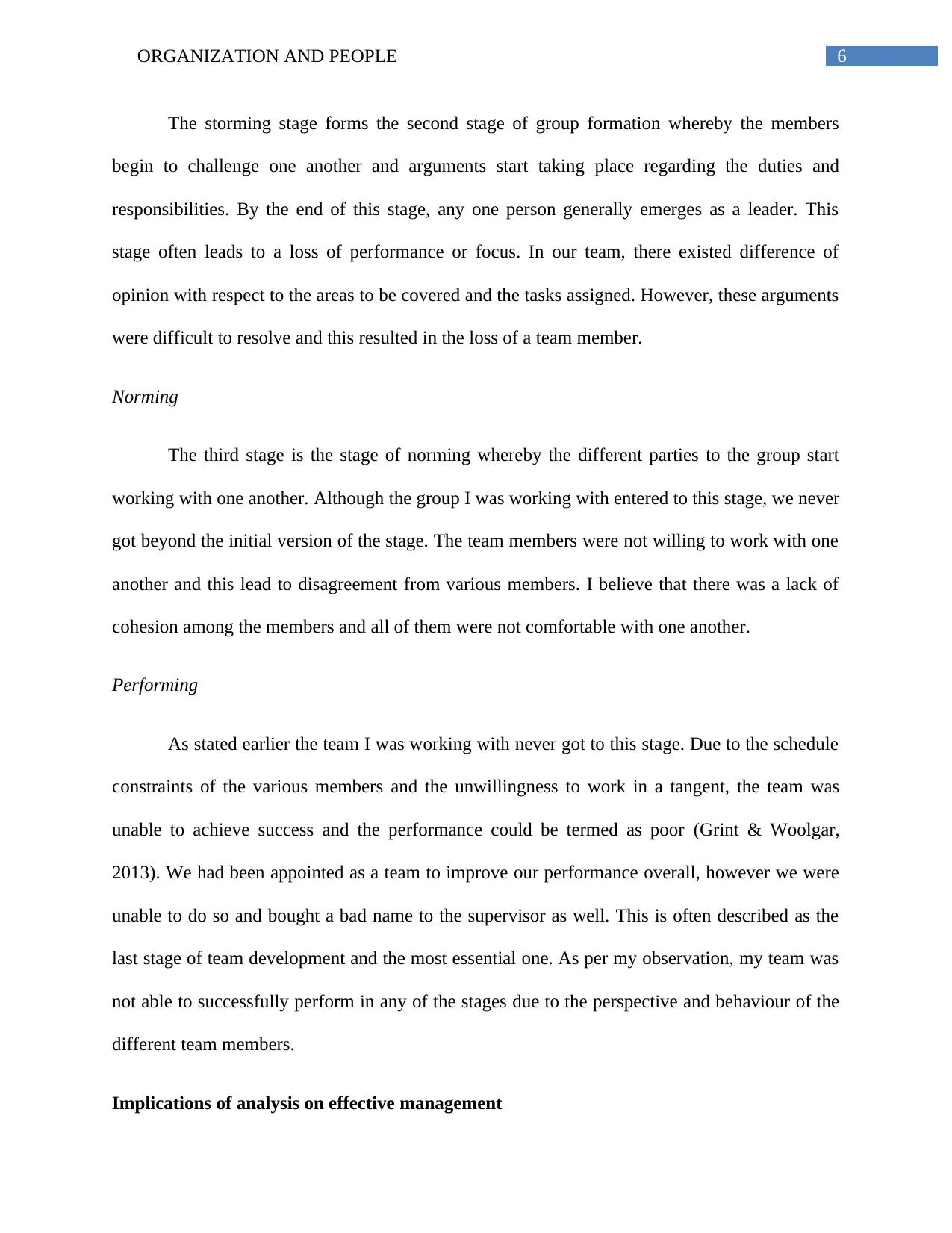
6ORGANIZATION AND PEOPLE
The storming stage forms the second stage of group formation whereby the members
begin to challenge one another and arguments start taking place regarding the duties and
responsibilities. By the end of this stage, any one person generally emerges as a leader. This
stage often leads to a loss of performance or focus. In our team, there existed difference of
opinion with respect to the areas to be covered and the tasks assigned. However, these arguments
were difficult to resolve and this resulted in the loss of a team member.
Norming
The third stage is the stage of norming whereby the different parties to the group start
working with one another. Although the group I was working with entered to this stage, we never
got beyond the initial version of the stage. The team members were not willing to work with one
another and this lead to disagreement from various members. I believe that there was a lack of
cohesion among the members and all of them were not comfortable with one another.
Performing
As stated earlier the team I was working with never got to this stage. Due to the schedule
constraints of the various members and the unwillingness to work in a tangent, the team was
unable to achieve success and the performance could be termed as poor (Grint & Woolgar,
2013). We had been appointed as a team to improve our performance overall, however we were
unable to do so and bought a bad name to the supervisor as well. This is often described as the
last stage of team development and the most essential one. As per my observation, my team was
not able to successfully perform in any of the stages due to the perspective and behaviour of the
different team members.
Implications of analysis on effective management
The storming stage forms the second stage of group formation whereby the members
begin to challenge one another and arguments start taking place regarding the duties and
responsibilities. By the end of this stage, any one person generally emerges as a leader. This
stage often leads to a loss of performance or focus. In our team, there existed difference of
opinion with respect to the areas to be covered and the tasks assigned. However, these arguments
were difficult to resolve and this resulted in the loss of a team member.
Norming
The third stage is the stage of norming whereby the different parties to the group start
working with one another. Although the group I was working with entered to this stage, we never
got beyond the initial version of the stage. The team members were not willing to work with one
another and this lead to disagreement from various members. I believe that there was a lack of
cohesion among the members and all of them were not comfortable with one another.
Performing
As stated earlier the team I was working with never got to this stage. Due to the schedule
constraints of the various members and the unwillingness to work in a tangent, the team was
unable to achieve success and the performance could be termed as poor (Grint & Woolgar,
2013). We had been appointed as a team to improve our performance overall, however we were
unable to do so and bought a bad name to the supervisor as well. This is often described as the
last stage of team development and the most essential one. As per my observation, my team was
not able to successfully perform in any of the stages due to the perspective and behaviour of the
different team members.
Implications of analysis on effective management
Paraphrase This Document
Need a fresh take? Get an instant paraphrase of this document with our AI Paraphraser
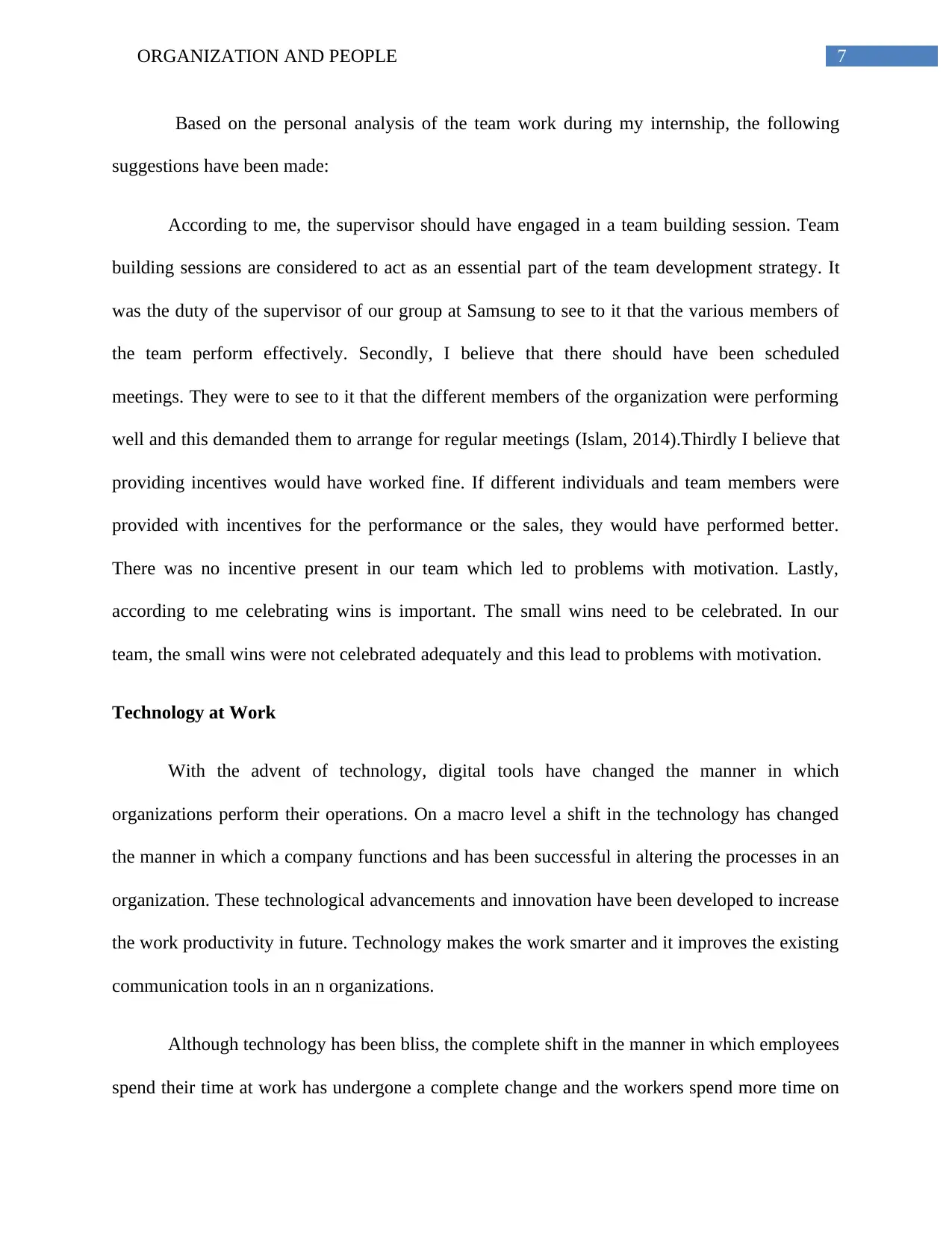
7ORGANIZATION AND PEOPLE
Based on the personal analysis of the team work during my internship, the following
suggestions have been made:
According to me, the supervisor should have engaged in a team building session. Team
building sessions are considered to act as an essential part of the team development strategy. It
was the duty of the supervisor of our group at Samsung to see to it that the various members of
the team perform effectively. Secondly, I believe that there should have been scheduled
meetings. They were to see to it that the different members of the organization were performing
well and this demanded them to arrange for regular meetings (Islam, 2014).Thirdly I believe that
providing incentives would have worked fine. If different individuals and team members were
provided with incentives for the performance or the sales, they would have performed better.
There was no incentive present in our team which led to problems with motivation. Lastly,
according to me celebrating wins is important. The small wins need to be celebrated. In our
team, the small wins were not celebrated adequately and this lead to problems with motivation.
Technology at Work
With the advent of technology, digital tools have changed the manner in which
organizations perform their operations. On a macro level a shift in the technology has changed
the manner in which a company functions and has been successful in altering the processes in an
organization. These technological advancements and innovation have been developed to increase
the work productivity in future. Technology makes the work smarter and it improves the existing
communication tools in an n organizations.
Although technology has been bliss, the complete shift in the manner in which employees
spend their time at work has undergone a complete change and the workers spend more time on
Based on the personal analysis of the team work during my internship, the following
suggestions have been made:
According to me, the supervisor should have engaged in a team building session. Team
building sessions are considered to act as an essential part of the team development strategy. It
was the duty of the supervisor of our group at Samsung to see to it that the various members of
the team perform effectively. Secondly, I believe that there should have been scheduled
meetings. They were to see to it that the different members of the organization were performing
well and this demanded them to arrange for regular meetings (Islam, 2014).Thirdly I believe that
providing incentives would have worked fine. If different individuals and team members were
provided with incentives for the performance or the sales, they would have performed better.
There was no incentive present in our team which led to problems with motivation. Lastly,
according to me celebrating wins is important. The small wins need to be celebrated. In our
team, the small wins were not celebrated adequately and this lead to problems with motivation.
Technology at Work
With the advent of technology, digital tools have changed the manner in which
organizations perform their operations. On a macro level a shift in the technology has changed
the manner in which a company functions and has been successful in altering the processes in an
organization. These technological advancements and innovation have been developed to increase
the work productivity in future. Technology makes the work smarter and it improves the existing
communication tools in an n organizations.
Although technology has been bliss, the complete shift in the manner in which employees
spend their time at work has undergone a complete change and the workers spend more time on
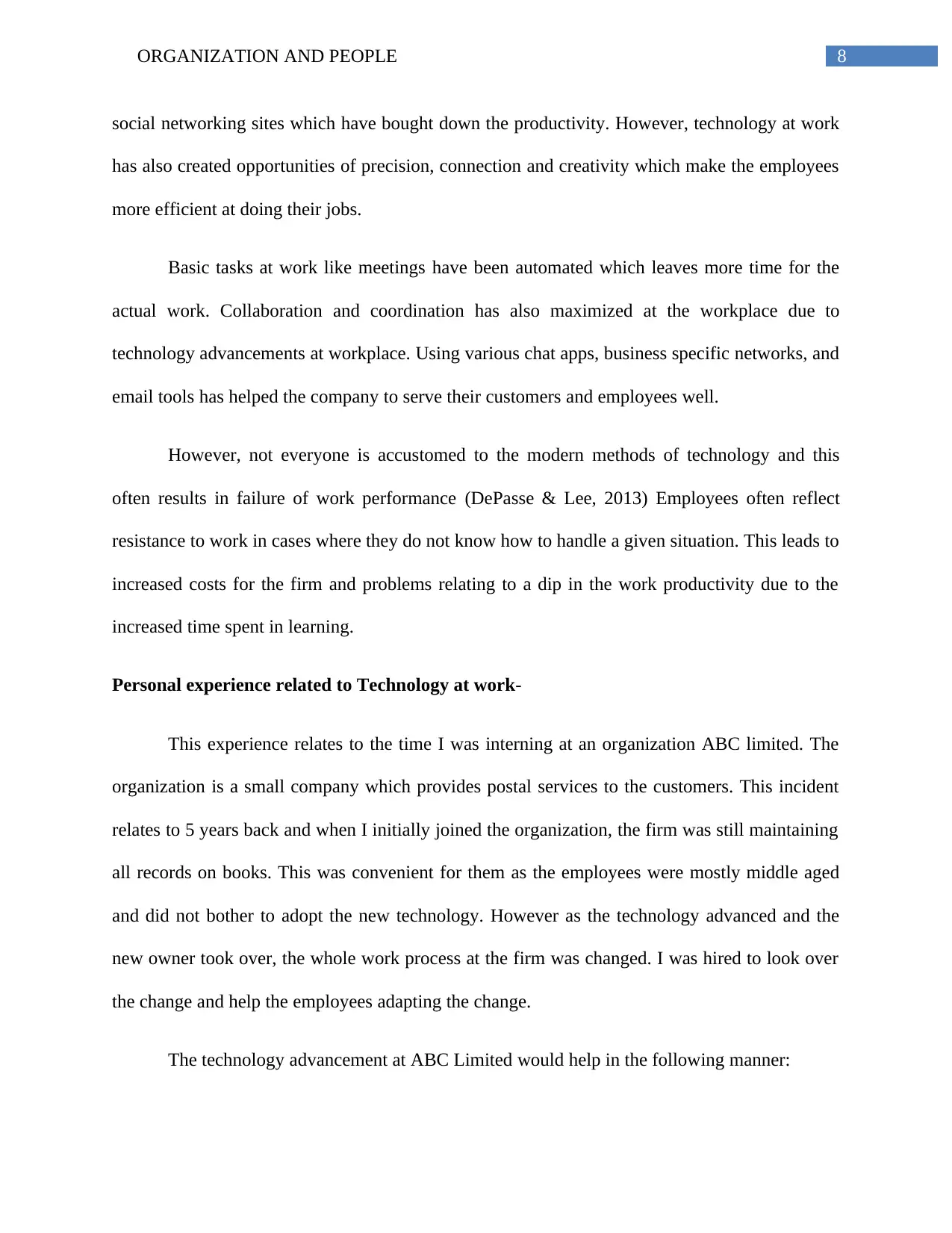
8ORGANIZATION AND PEOPLE
social networking sites which have bought down the productivity. However, technology at work
has also created opportunities of precision, connection and creativity which make the employees
more efficient at doing their jobs.
Basic tasks at work like meetings have been automated which leaves more time for the
actual work. Collaboration and coordination has also maximized at the workplace due to
technology advancements at workplace. Using various chat apps, business specific networks, and
email tools has helped the company to serve their customers and employees well.
However, not everyone is accustomed to the modern methods of technology and this
often results in failure of work performance (DePasse & Lee, 2013) Employees often reflect
resistance to work in cases where they do not know how to handle a given situation. This leads to
increased costs for the firm and problems relating to a dip in the work productivity due to the
increased time spent in learning.
Personal experience related to Technology at work-
This experience relates to the time I was interning at an organization ABC limited. The
organization is a small company which provides postal services to the customers. This incident
relates to 5 years back and when I initially joined the organization, the firm was still maintaining
all records on books. This was convenient for them as the employees were mostly middle aged
and did not bother to adopt the new technology. However as the technology advanced and the
new owner took over, the whole work process at the firm was changed. I was hired to look over
the change and help the employees adapting the change.
The technology advancement at ABC Limited would help in the following manner:
social networking sites which have bought down the productivity. However, technology at work
has also created opportunities of precision, connection and creativity which make the employees
more efficient at doing their jobs.
Basic tasks at work like meetings have been automated which leaves more time for the
actual work. Collaboration and coordination has also maximized at the workplace due to
technology advancements at workplace. Using various chat apps, business specific networks, and
email tools has helped the company to serve their customers and employees well.
However, not everyone is accustomed to the modern methods of technology and this
often results in failure of work performance (DePasse & Lee, 2013) Employees often reflect
resistance to work in cases where they do not know how to handle a given situation. This leads to
increased costs for the firm and problems relating to a dip in the work productivity due to the
increased time spent in learning.
Personal experience related to Technology at work-
This experience relates to the time I was interning at an organization ABC limited. The
organization is a small company which provides postal services to the customers. This incident
relates to 5 years back and when I initially joined the organization, the firm was still maintaining
all records on books. This was convenient for them as the employees were mostly middle aged
and did not bother to adopt the new technology. However as the technology advanced and the
new owner took over, the whole work process at the firm was changed. I was hired to look over
the change and help the employees adapting the change.
The technology advancement at ABC Limited would help in the following manner:
⊘ This is a preview!⊘
Do you want full access?
Subscribe today to unlock all pages.

Trusted by 1+ million students worldwide
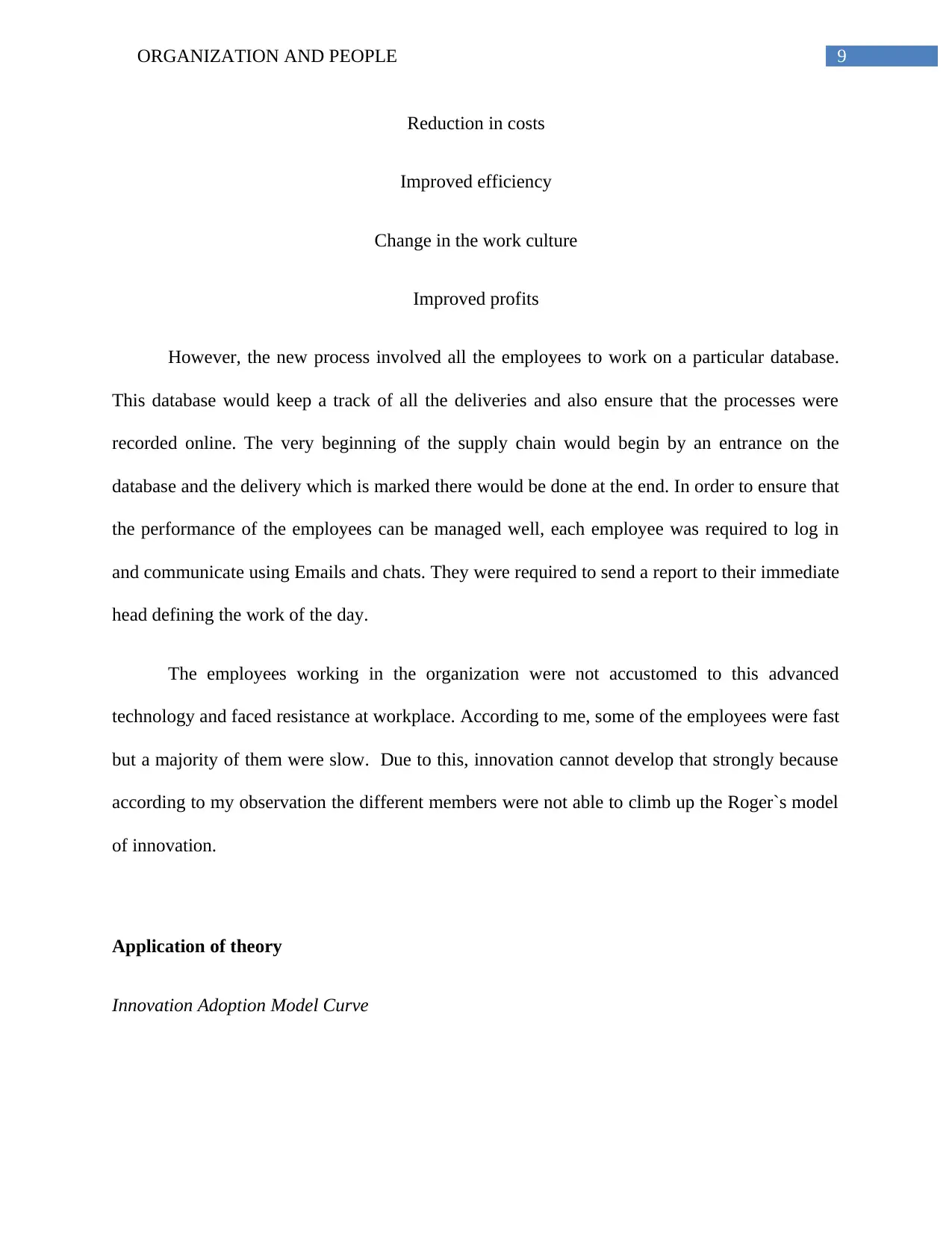
9ORGANIZATION AND PEOPLE
Reduction in costs
Improved efficiency
Change in the work culture
Improved profits
However, the new process involved all the employees to work on a particular database.
This database would keep a track of all the deliveries and also ensure that the processes were
recorded online. The very beginning of the supply chain would begin by an entrance on the
database and the delivery which is marked there would be done at the end. In order to ensure that
the performance of the employees can be managed well, each employee was required to log in
and communicate using Emails and chats. They were required to send a report to their immediate
head defining the work of the day.
The employees working in the organization were not accustomed to this advanced
technology and faced resistance at workplace. According to me, some of the employees were fast
but a majority of them were slow. Due to this, innovation cannot develop that strongly because
according to my observation the different members were not able to climb up the Roger`s model
of innovation.
Application of theory
Innovation Adoption Model Curve
Reduction in costs
Improved efficiency
Change in the work culture
Improved profits
However, the new process involved all the employees to work on a particular database.
This database would keep a track of all the deliveries and also ensure that the processes were
recorded online. The very beginning of the supply chain would begin by an entrance on the
database and the delivery which is marked there would be done at the end. In order to ensure that
the performance of the employees can be managed well, each employee was required to log in
and communicate using Emails and chats. They were required to send a report to their immediate
head defining the work of the day.
The employees working in the organization were not accustomed to this advanced
technology and faced resistance at workplace. According to me, some of the employees were fast
but a majority of them were slow. Due to this, innovation cannot develop that strongly because
according to my observation the different members were not able to climb up the Roger`s model
of innovation.
Application of theory
Innovation Adoption Model Curve
Paraphrase This Document
Need a fresh take? Get an instant paraphrase of this document with our AI Paraphraser
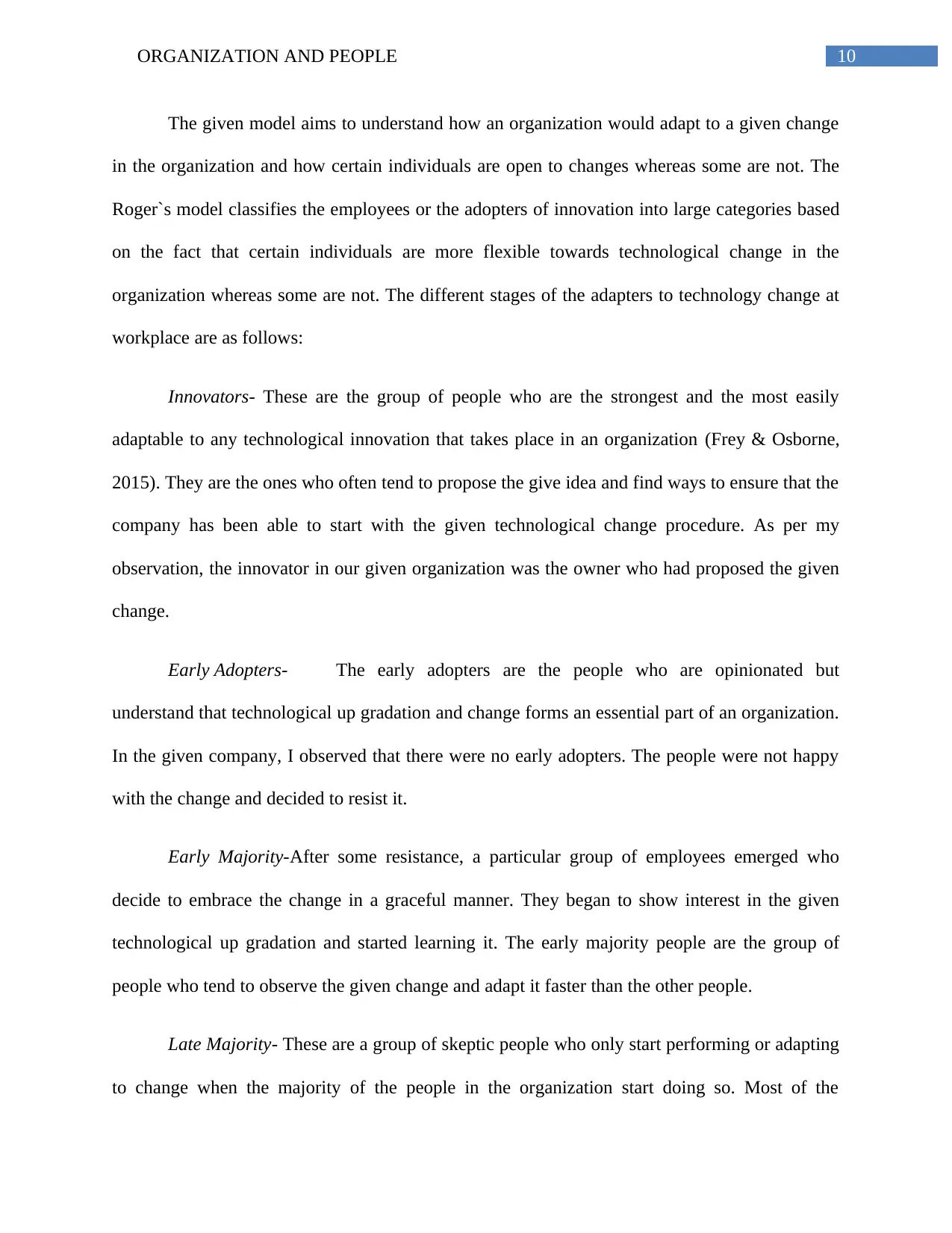
10ORGANIZATION AND PEOPLE
The given model aims to understand how an organization would adapt to a given change
in the organization and how certain individuals are open to changes whereas some are not. The
Roger`s model classifies the employees or the adopters of innovation into large categories based
on the fact that certain individuals are more flexible towards technological change in the
organization whereas some are not. The different stages of the adapters to technology change at
workplace are as follows:
Innovators- These are the group of people who are the strongest and the most easily
adaptable to any technological innovation that takes place in an organization (Frey & Osborne,
2015). They are the ones who often tend to propose the give idea and find ways to ensure that the
company has been able to start with the given technological change procedure. As per my
observation, the innovator in our given organization was the owner who had proposed the given
change.
Early Adopters- The early adopters are the people who are opinionated but
understand that technological up gradation and change forms an essential part of an organization.
In the given company, I observed that there were no early adopters. The people were not happy
with the change and decided to resist it.
Early Majority-After some resistance, a particular group of employees emerged who
decide to embrace the change in a graceful manner. They began to show interest in the given
technological up gradation and started learning it. The early majority people are the group of
people who tend to observe the given change and adapt it faster than the other people.
Late Majority- These are a group of skeptic people who only start performing or adapting
to change when the majority of the people in the organization start doing so. Most of the
The given model aims to understand how an organization would adapt to a given change
in the organization and how certain individuals are open to changes whereas some are not. The
Roger`s model classifies the employees or the adopters of innovation into large categories based
on the fact that certain individuals are more flexible towards technological change in the
organization whereas some are not. The different stages of the adapters to technology change at
workplace are as follows:
Innovators- These are the group of people who are the strongest and the most easily
adaptable to any technological innovation that takes place in an organization (Frey & Osborne,
2015). They are the ones who often tend to propose the give idea and find ways to ensure that the
company has been able to start with the given technological change procedure. As per my
observation, the innovator in our given organization was the owner who had proposed the given
change.
Early Adopters- The early adopters are the people who are opinionated but
understand that technological up gradation and change forms an essential part of an organization.
In the given company, I observed that there were no early adopters. The people were not happy
with the change and decided to resist it.
Early Majority-After some resistance, a particular group of employees emerged who
decide to embrace the change in a graceful manner. They began to show interest in the given
technological up gradation and started learning it. The early majority people are the group of
people who tend to observe the given change and adapt it faster than the other people.
Late Majority- These are a group of skeptic people who only start performing or adapting
to change when the majority of the people in the organization start doing so. Most of the
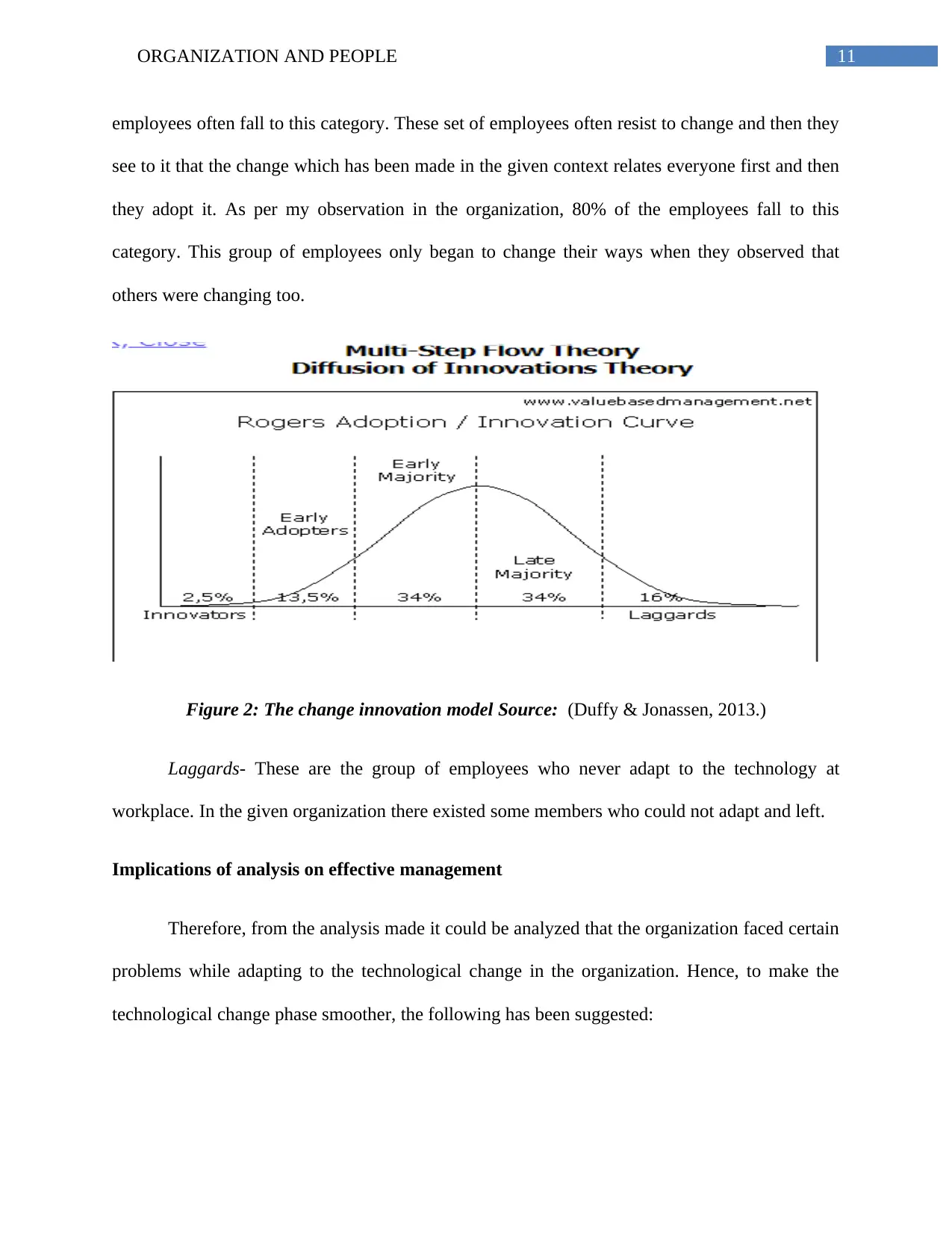
11ORGANIZATION AND PEOPLE
employees often fall to this category. These set of employees often resist to change and then they
see to it that the change which has been made in the given context relates everyone first and then
they adopt it. As per my observation in the organization, 80% of the employees fall to this
category. This group of employees only began to change their ways when they observed that
others were changing too.
Figure 2: The change innovation model Source: (Duffy & Jonassen, 2013.)
Laggards- These are the group of employees who never adapt to the technology at
workplace. In the given organization there existed some members who could not adapt and left.
Implications of analysis on effective management
Therefore, from the analysis made it could be analyzed that the organization faced certain
problems while adapting to the technological change in the organization. Hence, to make the
technological change phase smoother, the following has been suggested:
employees often fall to this category. These set of employees often resist to change and then they
see to it that the change which has been made in the given context relates everyone first and then
they adopt it. As per my observation in the organization, 80% of the employees fall to this
category. This group of employees only began to change their ways when they observed that
others were changing too.
Figure 2: The change innovation model Source: (Duffy & Jonassen, 2013.)
Laggards- These are the group of employees who never adapt to the technology at
workplace. In the given organization there existed some members who could not adapt and left.
Implications of analysis on effective management
Therefore, from the analysis made it could be analyzed that the organization faced certain
problems while adapting to the technological change in the organization. Hence, to make the
technological change phase smoother, the following has been suggested:
⊘ This is a preview!⊘
Do you want full access?
Subscribe today to unlock all pages.

Trusted by 1+ million students worldwide
1 out of 18
Related Documents
Your All-in-One AI-Powered Toolkit for Academic Success.
+13062052269
info@desklib.com
Available 24*7 on WhatsApp / Email
![[object Object]](/_next/static/media/star-bottom.7253800d.svg)
Unlock your academic potential
Copyright © 2020–2025 A2Z Services. All Rights Reserved. Developed and managed by ZUCOL.



